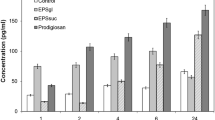Abstract
Crude lipids isolated fromBacillus firmus, but not from other bacilli, were previously found to induce significant resistance againstListeria monocytogenes infection in mice. In this study, formaldehyde-and heat-killed bacterins of eightBacillus species and some cellular fractions ofB. firmus were prepared and tested for further immunomodulatory activities. Crude lipids, their aqueous extract, LTA, Protodyne and Pex-residue preparations exhibited a strong anti-infection activity, whereas Pextract, P40 and all bacterins tested had no effect. Formaldehyde-killed bacterins, live bacteria and the P40 preparation of bothB. firmus strains, as well as bacterins of bothB. subtilis strains, induced pronounced splenomegaly in mice. Peptidoglycan and Pex-residue induced significant depression of cytochrome P-450 in mouse liver microsomes after application of 0.1 mg per mouse. Optimal conditions for obtaining a bacterial suspension exhibiting these immunomodulatory properties were elaborated.
Similar content being viewed by others
References
Berger F.M., Fukui G.M., Ludwig B.J., Rosselet J.P.: Increase of nonspecific resistance to infection of Protodyne, a protein component derived from bacterial protoplasm.Proc. Soc. Exp. Biol. Med.127, 556–559 (1968).
Bolen J.B., Tribble J.L.: Delayed hypersensitivity ofStaphylococcus aureus in mice:In vivo responses to isolated staphylococcal antigens.Immunology38, 809–817 (1979).
Bizzini B., Henocq E., Reynier J., Relyvend E.H.: Experimental and clinical results with theCorynebacterium granulosum-derived imunomodulator P 40.Asian Pacif. J. Allerg. Immunol.2, 144–153 (1984).
Carroll K.K., Cutts H.J., Murray E.G.D.: The lipids ofListeria monocytogenes.Can. J. Biochem.46, 899–904 (1968).
Coppi F., Ruoppolo M., Mandressi A., Bellorofonte C., Gonella G.: Results of the treatment withBacillus subtilis spores (Enterogermina) after antibiotic therapy in 95 patients with infection calculosis.Chemioterapia4, 467–470 (1985).
Fais S., Pallone F., Nava C., Magnani M.: Lymphocyte activation byB. subtilis spores.Boll. Ist. Sieroter. Milano66, 391–394 (1987).
Fiorini G., Cimminiello C., Chianese R., Visconti G.P., Cova D., Uberti T., Gibelli A.:Bacillus subtilis selectivelly stimulates the synthesis of membrane bound and secreted IgA.Chemioterapia4, 310–312 (1985).
Guenounou M., Gogoel A.F., Nauciel C.: Study of adjuvant and mitogenic activities of bacterial peptidoglycans with different structures.Ann. Immunol. Paris133 D, 3–13 (1982).
Houba V., Berger F.M., Dinarello C.A., Johnson A.G., Le J., Manel J., van der Meer J.W.M., Phillipeaux M.M., Vilcek J., Vogels M.T.E.: Protodyne: An immunomodulatory protein component, prepared fromBacillus subtilis.Int. J. Immunother.7, 109–116 (1991).
Laffan J.J., Firshein W.: Origin-specific DNA-binding membrane-associated protein may be involved in repression of initiation of DNA replication inBacillus subtilis.Proc. Nat. Acad. Sci.85, 7452–7456 (1988).
Lichtenstein A. Berek J.: Antitumor and immunologic effect of a pyridine-extracted fraction ofPropionibacterium acnes.Cancer Immunol. Immunother.22, 24–30 (1986).
Mára M., Julák J., Menčíková E., Očenášková J., Dohnalová A.: Effect of crude bacterial lipids on the course ofListeria infection in mice.Folia Microbiol.37, 455–460 (1992).
Omura T., Sato R.: The carbon-monoxide binding pigment of liver microsome.J. Biol. Chem. 239, 2370–2378 (1964).
Rasanen L., Mustikkamaki U.P., Leinikki P.: Enhancement of bacterial uptake and killing in lymphokine-activated human monocytes.Acta Pathol. Microbiol. Scand.89, 373–378 (1981).
Rasanen L., Mustikamakki U.P., Arvilommi H.: Polyclonal response of human lymphocytes to bacterial cell walls, peptidoglycans and teichoic acids.Immunology46, 481–486 (1982).
Rasanen L., Lehto M., Jokinen I., Leinikki P.: Polyclonal antibody formation of human lymphocytes to bacterial components.Immunology58, 577–581 (1986).
Ruiz Bravo A., Kouwatli K., Alvarez de Cienfuegos G., Ramos Cormenzana A.: Immunomodulation in mice byBacillus megaterium and its dependence on culture conditions.Immunol. Lett.3, 39–43 (1981).
Verbrugh H.A., Peters R., Rozenberg-Arska M., Peterson P.K., Verhoef J.: Antibodies to cell wall peptidoglycan ofStaphylococcus aureus in patients with serious staphylococcal infections.J. Infect. Dis.144, 1–9 (1981).
Wergeland H.I., Endersen C.: Antibodies to various bacterial cell wall peptidoglycans in human and rabbit sera.J. Clin. Microbiol.25, 540–545 (1987).
Zatula D.G.: Experimental and clinical results of application of antitumor vaccines obtained by means of bacterial metabolism.Neoplasma31, 65–74 (1984).
Zatula D.G., Lisovenko G.S., Siadro T.A.: Possible role ofBacillus megaterium H antigens common with tumor antigens in the increase of the antitumor activity of lymphocytes.Exp. Oncology6, 45–47 (1984).
Zatula D.G., Lisovenko G.S., Siadro T.A.: Modification of 3-methylcholanthrene induced blastomogenesis in BALB/c mice by using the subcellular components ofBacillus megaterium H.Exp. Oncology7, 18–20 (1985).
Zatula D.G., Lisovenko G.S., Siadro T.A.: Effect ofBacillus megaterium H on the immune response to heterologous antigen in mice.Mikrobiol. Zh.48, 77–81 (1986).
Author information
Authors and Affiliations
Rights and permissions
About this article
Cite this article
Mára, M., Očenášková, J., Nováková, M. et al. Resistance to infection and activation of the monocyto-macrophage system caused byBacillus firmus and its fractions. Folia Microbiol 39, 147–151 (1994). https://doi.org/10.1007/BF02906811
Received:
Revised:
Issue Date:
DOI: https://doi.org/10.1007/BF02906811



